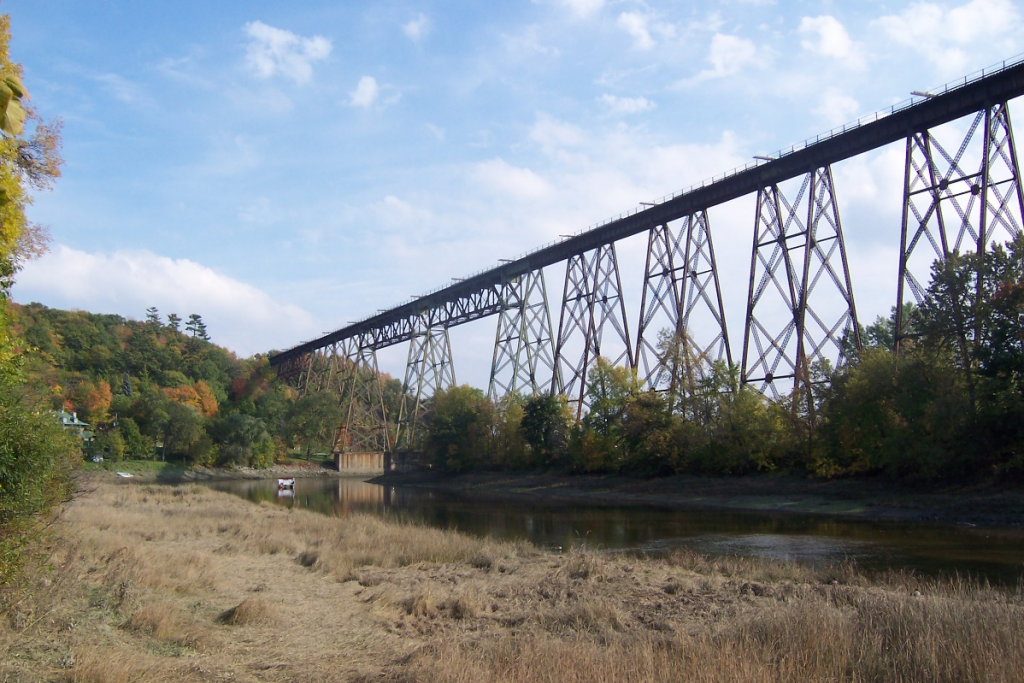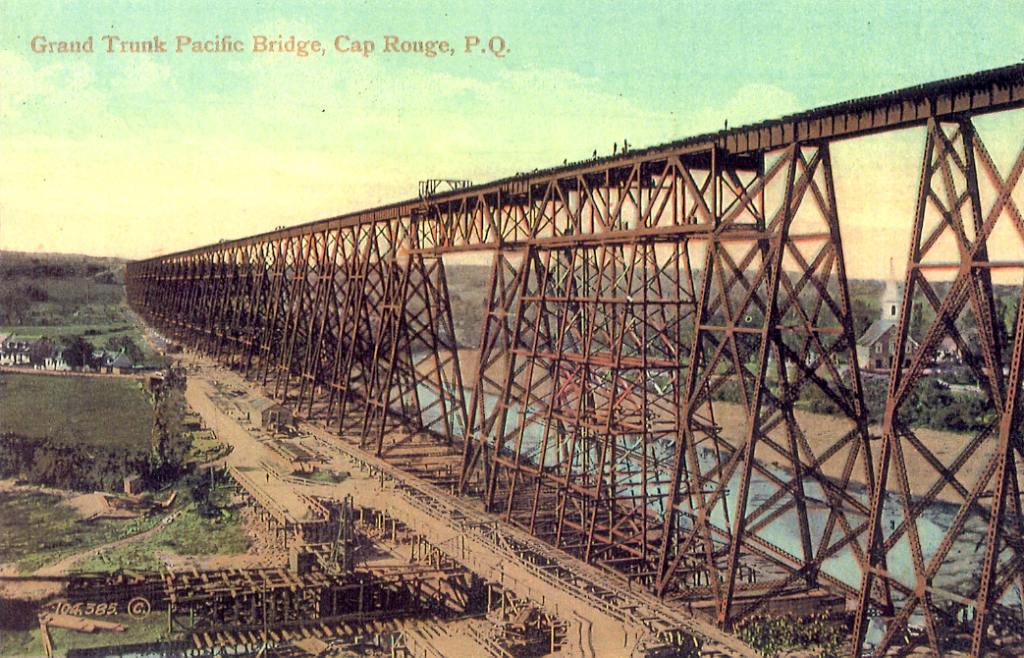

Site Location: Lat.: 46° – 44’ – 53” N; Long.: 71° – 20’ – 59” W. (GPS: 46.7480842, -71.3496766). Take Exit 302 of Autoroute Félix Leclerc (40) to travel south on Route Jean-Gauvin: travelling eastbound, turn left (east) at the T-junction on Rue de l’Hétrière then take the first right (south) on Jean-Gauvin; travelling westbound, take the ramp to turn right (east) on Avenue Jules-Verne and the first right, again a ramp, on Jean-Gauvin. Continue 1.3 km, as Jean-Gauvin becomes Rue du Domaine, and turn right (south) midway through a left turn onto Rue de la Poterie. Continue 0.8 km to the T-junction at Boulevard de la Chaudière and turn right (south). Proceed 0.5 km, going under the trestle, and turn left (east) on Rue Saint-Félix. Proceed 0.6 km and, just before passing under the trestle, turn right into a parking lot at the Parc Nautique de Cap-Rouge.
Plaque Location: The plaque is located on a concrete pedestal between the parking lot and the trestle, on the outside of the Rue Saint-Félix turn.

Description: This train trestle was constructed across the Cap Rouge River valley between 1906 and 1913 to allow trains on the National Transcontinental Railway to approach the nearby high-level Quebec Bridge. It is 1017 m (3336 ft.) long and 52.4 m (172 ft.) high. The Dominion Bridge Company fabricated and erected the structural steel. Three of the foundations were founded on bedrock using pneumatic caissons, a procedure that markedly increased the final cost of the structure. The term “tracel” became popular with French-speaking locals who frequently heard the structure described using the English word “trestle”.


Historic Significance: The Tracel Cap-Rouge is the first steel railway trestle, or “saw-horse bridge” built in Canada. The use of pneumatic caissons to construct the foundation is also historically significant. The Dominion Bridge Company (1883-1998) was Canada’s most significant steel company in the 20th century, building iconic bridges and buildings across Canada. The National Transcontinental Railway merged with the Canadian Northern Railway in 1923 to become Canadian National, now CN. The Tracel is a symbol of pride for the residents of Cap-Rouge, particularly for the descendants of the workers who built it.

Plaque Wording: National Historic Civil Engineering Site. CSCE. TRACEL DE CAP-ROUGE (CAP-ROUGE TRESTLE). A tribute to the engineers and constructors who designed and built the tracel de Cap-Rouge, the first railway trestle of its type in Canada, commenced in 1906. This steel structure was built for the National Transcontinental Railway by the Lachine based Dominion Bridge Company and fully commissioned in 1913. It is 1017 metres long with a height of 52.4 metres at low tide and is significant for its impressive steel spans and for the pneumatic caisson technique employed in the construction of the foundations in the bed of the river. Canadian Society for Civil Engineering. 2013.
SCGC. Site Historique National de Génie Civil. TRACEL DE CAP-ROUGE. Un hommage aux ingénieurs et aux bâtisseurs que ont conçu et construit le tracel de Cap-Rouge, premier viaduct ferroviare àchevalets en importance au Canada, au tout début de sa construction en 1906. Ce viaduct fut autorisé par la commission de Chemin de Fer National Transcontinental, construit par la Société Dominion Bridge Company de Lachine et mis en service en 1913. D’une longeur de 1017 metres et d’une hauteur de 52,4 metres à marée basse, cette oeuvre en acier se distinguee par ses poutres à treillis, appelée poutres Eiffel ou poutres rivetées, ansi que par sa technique de fonçaga à air comprimé des fondations de béton jouxtant la rivière. 2013. Société canadienne de genie civil.
Plaque Unveiling Ceremony (November 7, 2017):

Links to Online Documentation:
Yolande Perron, “Le Tracel de Cap-Rouge”, Canadian Civil Engineer, 2013. (See page 12.)